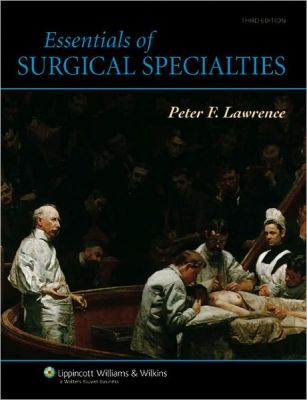Essentials of Surgical Specialties / Edition 3
by Merril T. Dayton (Editor), Richard M. Bell-
Paperback
$48.30
Essentials of Surgical Specialties, Third Edition provides students with exactly what they need to learn and retain the clinical foundations in surgical specialties. Organized by specialty, the book explains the basic skills needed in nine core rotations and prepares students for their clerkship. More than 200 illustrations demonstrate relevant anatomy and common surgical approaches.
This edition provides updated information on treatment options, imaging modalities, operative techniques, laparoscopic and robotic surgery, surgical devices and products, and postoperative care. Multiple-choice questions have been expanded and rewritten to NMBE format.
A multiple-choice question bank will be available online at thePoint.
Jay B. Prystowsky
This book is intended to serve as a source for medical students for describing the fundamental principles in the surgical specialties that every student should master. The stated purpose is to provide a readable textbook for third- and fourth-year medical students in which all the important principles of the surgical specialties are presented in a concise, organized fashion. The text achieves this purpose admirably in that the book is clearly written at the medical student level. The audience for this text is third- and fourth-year medical students. Each chapter follows a similar format in that assumptions as to the student's knowledge base are made, objectives for the students are clearly defined, important technical skills are emphasized, a brief reference list of established sources is noted, and study questions are provided. The illustrations, tables, algorithms, and photographs are of satisfactory quality and complement the text well. The text does not attempt to be all inclusive; uncommon entities are generally not discussed. The type is large and easy to read. The writing is clear and well organized. The editors believe that the length of the book should allow students to read it within six weeks. However, at 400 pages, it is doubtful that most medical students can read this text in that time frame. This is an excellent summation of the important principles of the surgical specialties. The format is useful for students in helping them to prioritize the fundamental points of each specialty. It is a useful adjunct to undergraduate surgical education.
David A. Bloom
This is a highly useable and interactive text that is a good review of anesthesiology and eight surgical sub-specialties targeted to medical students. Not only are the objectives of each chapter outlined at the beginning, but multiple-choice questions, explanations of the objectives, and case scenarios follow each text. Three medical student editors were involved in this publication and their presence seems to be reflected in the user-friendly nature of this work. The first edition was published in 1993 and it appears that this is not only an effort to update material, but also to finely tune this work. The editor explains that his aim is to educate medical students who will be going into primary care fields regarding the surgical sub-specialties. I believe his purpose fulfills a tremendous void in current medical education. This book fills this niche nicely in undergraduate medical education, but also should be a core part of the curriculum of non-surgical residencies and a part of any basic primary care library. The material covered in this book includes basic medical problems that everyone on the planet will eventually encounter in one way or another. Medical students are the intended audience. The editor and contributors are all credible authorities in their subject matters. The practical nature of this text cannot be understated. Each chapter is a well-constructed program of self-study. One might argue about the inclusiveness of the eight sub-specialties, but I believe that they provide a fair overview. There are a few omissions and overlaps, which may be corrected in a future edition. The order of the chapters lacks logical continuity -- appropriately anesthesiology iscovered first, but after that there is neither alphabetical anatomic nor historical rationale for the priority of the next eight chapters. Circumcision and undescended testicles are doubly covered in the pediatric surgery and the urology sections. Burns are included in pediatric surgery, but not elsewhere in the text, and are specifically lacking in the plastic surgery section. The issues of ambiguous genitalia and intersex deserve short inclusion. These are topics of increasingly intense concern in society and while they are not the ""common conditions"" targeted by the editor, they are certainly more common than a number of other items discussed in the text and merit acknowledgement somewhere in the undergraduate medical curriculum and in the wider world of primary care. This is a high quality, useful book. I really couldn't find a comparable competitor in the marketplace. As a second edition, a full seven years after the original, it seem this is a timely update.
Booknews
Intended as a overview for medical students not entering a surgical field, this textbook is designed to be used in conjunction with the same authors' textbook in general surgery, Contributors here address only the most important principles and the common diseases pertaining to their specialty; uncommon diseases are not discussed. Multiple choice and practice oral examination questions appear at the end of every chapter. Lawrence is affiliated with the University of California, Irvine. Annotation c. Book News, Inc., Portland, OR (booknews.com)
From The Critics
Reviewer: Jay B. Prystowsky, MD (Northwestern University Feinberg School of Medicine)
Description: This book is intended to serve as a source for medical students for describing the fundamental principles in the surgical specialties that every student should master.
Purpose: The stated purpose is to provide a readable textbook for third- and fourth-year medical students in which all the important principles of the surgical specialties are presented in a concise, organized fashion. The text achieves this purpose admirably in that the book is clearly written at the medical student level.
Audience: The audience for this text is third- and fourth-year medical students.
Features: Each chapter follows a similar format in that assumptions as to the student's knowledge base are made, objectives for the students are clearly defined, important technical skills are emphasized, a brief reference list of established sources is noted, and study questions are provided. The illustrations, tables, algorithms, and photographs are of satisfactory quality and complement the text well. The text does not attempt to be all inclusive; uncommon entities are generally not discussed. The type is large and easy to read. The writing is clear and well organized. The editors believe that the length of the book should allow students to read it within six weeks. However, at 400 pages, it is doubtful that most medical students can read this text in that time frame.
Assessment: This is an excellent summation of the important principles of the surgical specialties. The format is useful for students in helping them to prioritize the fundamental points of each specialty. It is a useful adjunct to undergraduate surgical education.
4 Stars! from Doody


